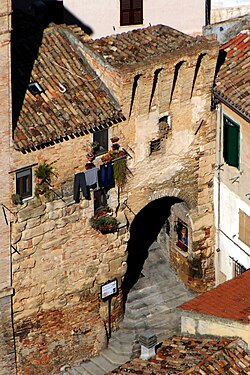Osimo: Difference between revisions
No edit summary |
|||
| Line 34: | Line 34: | ||
'''Vetus Auximum''' was founded by the same Greek colonists of Ancona; later it was conteded between the [[Gauls]] and the [[Piceni]], until conquered by the [[Ancient Rome|Romans]], who used it as a fortress for their northern [[Picenum]] settlement starting from 174 BC. The walls were made of large rectangular stones which are still there in some part. It was a colony until 157 BC. The family of [[Pompey]] were its protectors and resisted [[Julius Caesar|Caesar]] in 49 BC. It is considered to have been important during imperial times due to inscriptions and monuments in its town square. |
'''Vetus Auximum''' was founded by the same Greek colonists of Ancona; later it was conteded between the [[Gauls]] and the [[Piceni]], until conquered by the [[Ancient Rome|Romans]], who used it as a fortress for their northern [[Picenum]] settlement starting from 174 BC. The walls were made of large rectangular stones which are still there in some part. It was a colony until 157 BC. The family of [[Pompey]] were its protectors and resisted [[Julius Caesar|Caesar]] in 49 BC. It is considered to have been important during imperial times due to inscriptions and monuments in its town square. |
||
In the 6th century it was |
In the 6th century it was besieged twice in the course of the [[Gothic War (6th century)|Gothic War]], by [[Belisarius]] and [[Totila]]; the [[Byzantine Empire|Byzantine]] historian [[Procopius]] said it was the leading town of Picenum. |
||
Later it was a Papal possession, but in 1100 it was a free commune. It was returned to the Popes by Cardinal [[Gil de Albornoz]], while in 1399-1430 it was a fief of the [[house of Malatesta|Malatesta]] family, who built here a ''rocca'' ("castle", now disappeared). Subsequently it was again part of the [[Papal States]] until the [[unification of Italy]] in 1861. |
Later it was a Papal possession, but in 1100 it was a free commune. It was returned to the Popes by Cardinal [[Gil de Albornoz]], while in 1399-1430 it was a fief of the [[house of Malatesta|Malatesta]] family, who built here a ''rocca'' ("castle", now disappeared). Subsequently it was again part of the [[Papal States]] until the [[unification of Italy]] in 1861. |
||
Revision as of 15:23, 28 July 2009
Osimo | |
|---|---|
| Comune di Osimo | |
 Musone Gate. | |
| Coordinates: 43°29′N 13°29′E / 43.483°N 13.483°E | |
| Country | Italy |
| Region | Marche |
| Province | Ancona (AN) |
| Frazioni | Osimo Stazione, Passatempo, Casenuove, Campocavallo, Padiglione, Abbadia, San Paterniano, Santo Stefano, San Biagio, Santa Paolina |
| Government | |
| • Mayor | Stefano Simoncini (since June 2009) |
| Area | |
• Total | 105 km2 (41 sq mi) |
| Population (2018-01-01)[2] | |
• Total | 32,457 |
| • Density | 310/km2 (800/sq mi) |
| Demonym | Osimani |
| Time zone | UTC+1 (CET) |
| • Summer (DST) | UTC+2 (CEST) |
| Postal code | 60027 |
| Dialing code | 071 |
| Patron saint | St. Joseph of Cupertino |
| Saint day | September 18 |
| Website | www.comune.osimo.an.it |
Osimo (anc. Vetus Auximum) is a town and commune of the Marche, Italy, in the province of Ancona, 15 km south of that town by rail. It is situated on a hill near the Adriatic Sea.
Silk-spinning and the raising of cocoons are carried on.
History
Vetus Auximum was founded by the same Greek colonists of Ancona; later it was conteded between the Gauls and the Piceni, until conquered by the Romans, who used it as a fortress for their northern Picenum settlement starting from 174 BC. The walls were made of large rectangular stones which are still there in some part. It was a colony until 157 BC. The family of Pompey were its protectors and resisted Caesar in 49 BC. It is considered to have been important during imperial times due to inscriptions and monuments in its town square.
In the 6th century it was besieged twice in the course of the Gothic War, by Belisarius and Totila; the Byzantine historian Procopius said it was the leading town of Picenum.
Later it was a Papal possession, but in 1100 it was a free commune. It was returned to the Popes by Cardinal Gil de Albornoz, while in 1399-1430 it was a fief of the Malatesta family, who built here a rocca ("castle", now disappeared). Subsequently it was again part of the Papal States until the unification of Italy in 1861.
Main sights
Osimo retains a portion of its ancient town wall (2nd century BCE).
The restored Romanesque-Gothic Cathedral (8th-12th centuries) has a portal with sculptures of the 13th century, an old crypt, a fine bronze font of the 16th century and a series of portraits of all the bishops of the old diocese of Osimo. The baptistery is from the early 17th centuryhas a notable baptismal font.
The town hall contains a number of statues found on the site of the ancient forum. The second oldest church in Osimo is that of San Giuseppe da Copertino, built in the 13th century
Under the town is a large series of tunnel with exoteric bas-reliefs.
The new castle (1489), of which parts remain today, was built by Baccio Pontelli.
Twin towns
See also
References
- ^ "Superficie di Comuni Province e Regioni italiane al 9 ottobre 2011". Italian National Institute of Statistics. Retrieved 16 March 2019.
- ^ "Popolazione Residente al 1° Gennaio 2018". Italian National Institute of Statistics. Retrieved 16 March 2019.
- ^ Comune di Osimo, project "Prevenzione Sicurezza" in Vivi la città
This article incorporates text from a publication now in the public domain: Chisholm, Hugh, ed. (1911). Encyclopædia Britannica (11th ed.). Cambridge University Press. {{cite encyclopedia}}: Missing or empty |title= (help)



